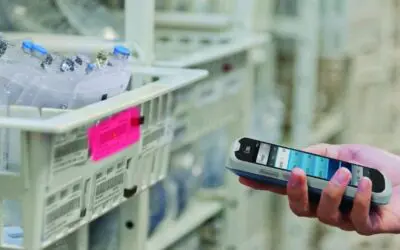Thermal printers are used in a wide variety of applications today, showing up everywhere from shipping labels in e-commerce fulfillment operations to patient identification wristbands in hospital maternity wards. Compared to laser and inkjet printing technologies, thermal printers offer fast output, easy operation, and longer printer life, making it natural to consider whether thermal printers are right for your business.
The Basics: Thermal Printing Technology
Thermal printing comes in two types: direct thermal and thermal transfer. Both use a heated printhead to transfer the printed image to the print media. With direct thermal printing, the media itself is heat sensitive, so the output is transferred directly to the label or paper. Thermal transfer printers add a heat sensitive ribbon to the equation, allowing them to transfer images to a wide range of labels, paper, and other materials.
Direct thermal and thermal transfer technology both produce high-quality images with excellent edge definition, making them ideal for one- and two-dimensional barcode labels, graphics, and text. Both technologies also offer a range of print resolutions and output speeds.
From an application perspective, the primary distinction between direct thermal and thermal transfer printing is durability and longevity. Direct thermal printers are suitable for many uses, but the labels remain sensitive to heat and light even after they’re printed, and the images can degrade or fade, making barcodes unreadable over time.
Thermal Printing Media Longevity: Direct Thermal vs. Thermal Transfer
Anyone who has kept a gas station or credit card receipt in a wallet or purse for several months is probably familiar with the durability issues of direct thermal printing. Often, those receipts fade to the point of becoming illegible. This illustrates why you’ll see direct thermal printers used for output that has a relatively short shelf-life such as shipping labels and visitor tags, but thermal transfer printers are a better option for labels that remain in circulation for an extended period.
With a thermal transfer printer, the printhead melts ink from the thermal transfer ribbon onto the label and the ink becomes part of the media. When the thermal transfer ribbon is properly matched to the print media, you can create a durable, long-lasting image that is essentially impervious to heat, light and moisture. The result is a scratch- and fade-resistant label that can remain readable for years.
This highlights the importance of carefully selecting the label material and ribbon to ensure print quality and durability. With the right media/ribbon combination, you can create labels that are able to withstand exposure to extreme temperatures, ultraviolet light, chemicals, and moisture that would ruin most direct thermal labels.
Read to learn more? Contact MSM Solutions for a thermal printer recommendation.


